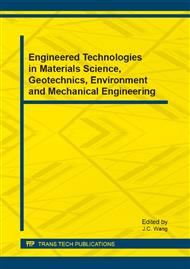[1]
Cheng Junliu, Harry Wechsler, "A shape- and texture-basedenhanced Fisher classifier for face recognition," IEEE Trans Image processing. Papers 10(4), 598-608 (2001).
DOI: 10.1109/83.913594
Google Scholar
[2]
Yang Jian, Yang Jinyu, "Feature fusion: parallel strategy vs. serial strategy," Pattern Recognition. Papers 36(6), 1369-1381 (2003).
DOI: 10.1016/s0031-3203(02)00262-5
Google Scholar
[3]
HE Guo-hui,GAN Jun-ying, LI Chun-zhi, GAO Jian-hu, "A Model Study for Face and Iris Feature Fusion and Recognition," Acta Electronica Sinica. Papers 35(7), 1365-1371 (2007).
Google Scholar
[4]
Sun Quansen,. "Face recognition based on generalized canonical correlation analysis," Proceedings of International Conference on Intelligent Computing. Proc. 958-967 (2005).
Google Scholar
[5]
SUN Quan-Sen, ZENG Sheng-Gen, HENG Pheng-Ann, XIA De-Shen, "The Theory of Canonical Correlation Analysis and Its Application to Feature Fusion," Chinese Journal of Computers. Papers 28(9),1524-1533 (2005)..
DOI: 10.1109/icarcv.2004.1469081
Google Scholar
[6]
Zhao Song, Zhang Zhijian, Zhang Peiren, "Enhanced CCA and its Applications in Feature Fusion of Face Recognition," Journal of Computer-aided Design & Computer Graphics. Papers 21(3), 394-399 (2009).
Google Scholar
[7]
Wang Hui-wen, [partial least squares regression method and its application], Beijing: National Defence Industry Press (1999).
Google Scholar
[8]
WOLD S, SJOSTOM m, et al., "PLS regression: a basic tool of chemometrics," Chemometrics and Intelligents Laboratory Systems. Papers 58, 109-130 (2001).
DOI: 10.1016/s0169-7439(01)00155-1
Google Scholar
[9]
BAEK J, KIM M., "Face recognition using partial least squares components," Pattern Recognition. Papers 37(6), 1303-1306 (2004).
DOI: 10.1016/j.patcog.2003.10.014
Google Scholar
[10]
ZHAO Jianping, HUANG Jianguo, XIE Yiqing, ZHANG Huafeng, "Transient feature extraction and discrimination of wideband echos based on wavelet transform," Acta Acustica. Papers 23(1),31-38 (1998).
Google Scholar
[11]
BU Ying-yong, ZHANG Chao, NIE Shuang-shuang, "Tail-Wave Envelop Feature Extraction of an Underwater Echo Based on Discrete Wavelet Transform," Journal of Zhengzhou University (Engineering Science). Papers 28(4), 80-83 (2007).
Google Scholar
[12]
Bengio Y, Grandvalet Y., "Bias in Estimating the Variance of K-Fold Cross-Validation," Statistical Modeling and Analysis for Complex Data Problems. Papers 1, 75-95 (2005).
DOI: 10.1007/0-387-24555-3_5
Google Scholar


